![]()
![]()
![]()
Use LEFT and RIGHT arrow keys to navigate between flashcards;
Use UP and DOWN arrow keys to flip the card;
H to show hint;
A reads text to speech;
53 Cards in this Set
- Front
- Back
- 3rd side (hint)
|
Restriction enzymes
|
a special class of DNA cuttin enzymes that exist in many bacteria. their names are derived from the microbe in which they were first discovered
they all cut DNA at specific recognition sites (the cell that contains the enzymes, methylates its own DNA at those sites) the recognition sites are often palindromic |
|
|
|
most often the restriction enzyme produces...?
|
staggered (sticky) ends, but sometimes blunt ends are produced.
|
|
|
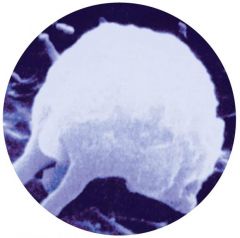
Pneumocystis jirovecii was thought to be a protozoan until DNA analysis showed it is a fungus. Why does it matter whether an organism is classified as a protozoan or a fungus?
|
The organism is HIV. Its is important if you are creating theraputic agents to kill it.
|
|
|
|
Taxonomy
|
The science of classifying organisms;Provides universal names for organisms;Provides a reference for identifying organisms
|
|
|
|
Systematics, or Phylogeny
|
The study of the evolutionary history of organisms;All Species Inventory (2001–2025)
To identify all species of life on Earth |
|
|
|
Placing Bacteria
|
1735-Kingdoms Plantae and Animalia
1961-Prokaryote defined as cell in which nucleoplasm is not surrounded by a nuclear membrane 1978-Two types of prokaryotic cells found |
|
|
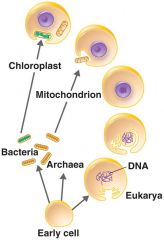
This is a model of what?
|
A model of the orgin of Eukaryotes. It also demenstrates endosymbiotic theory. Also, the enfolding of plasma membrane resulted in the ....? Mitochondria came from?
Plastids " " ? |
1) endomembran system
2) rickettsias 3) Plastids |
|
|
Endosymbiotic Theory
|
a model for the evolution of eukaryotes which states that organelles arose from prokaryotic cells living inside a host prokaryote.
|
|
|

What organism is this and requires what to survive?
|
Cyanophora paradoxa, that requires its endosymbiont to survive. or pharsed another way eukaryotic host and the bacterium require each other for survival, provides a modern example of how eukaryotic cells might have evolved.
|
|
|
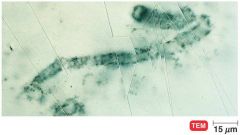
What is this showing a picture of?
|
Fossilized Prokaryotes. and what prokaryote and how many year old?
|
3.5 million years ago-cyanobacteria
|
|
|
most microorganisms are not readily_________ but there are _______.
|
fossilized, exceptions
|
|
|
|
The exception of microorganisms that can fossilze are....?
|
marine protists in White Cliffs of Dover, England
-stromatolites -fossilzed cyanobacteria in rocks in Western Australia. |
|
|

A is a picture of what?
|
A picture of fossilzed bacteria n rocks of Western Australia betw. 3.0-3.5 billion years ago.
|
|
|

This is a picture of what?
|
stromatolites that still....?
|
exist but were more plentiful in earlier Earth history
|
|

Name the sections starting clockwise at the the twelve ockle position.
|
formation of the earth, orgin of prokaryotes, orgin of oxygenating photosynthesis, orgin of Eukaryotes, Emergence of Animals
|
|
|
|
Phylogenetics
|
each species retain some characteristics of its ancestor. Also grouping organisms according to common properties that a group of organisms evolved from a common ancestor such as anatomy, fossils, and rRNA (most important).
|
|
|
|
Taxon (taxa - plural)
|
a taxonomic category
|
|
|
|
phylogeny
|
the study of the evolutionary history of organisms; hierarchy reflects evolutionary phylogenetic relationships
|
|
|
|
systematics
|
the study of phylogenetic classification
|
|
|
|
Carl Woese’s work with...
|
small subunit ribosomal RNA (16S RNA): 3 domains, Archaea, Bacteria, Eukarya
|
|
|
|
Those responsibly for naming organism and give name approval are?
|
International Code of Zoological Nomenclature (animals)
International Code of Botanical Nomenclature (plants) International Committee on Systematic Bacteriology - Bacteriological Code |
|
|
|
Klebsiella pneumoniae, what the source of genus name and specific epithet?
|
Honors Edwin Klebs;The disease
|
|
|
|
Pfiesteria piscicida what the source of genus name and specific epithet?
|
Honors Lois Pfiester;Disease in fish
|
|
|
|
Salmonella typhimurium what the source of genus name and specific epithet?
|
Honors Daniel Salmon;Stupor (typh-) in mice (muri-)
|
|
|
|
Streptococcus pyogenes what the source of genus name and specific epithet?
|
Chains of cells (strepto-);Forms pus (pyo-)
|
|
|
|
Penicillium chrysogenum what the source of its genus name and source of specific epithet?
|
Tuftlike (penicill-);Produces a yellow (chryso-) pigment
|
|
|
|
Trypanosoma cruzi what the source of its genus name and source of specific epithet?
|
Corkscrew-like (trypano-, borer; soma-, body);Honors Oswaldo Cruz
|
|
|
|
Taxonomic Hierarchy
|
Domain,Kingdom, phylum,class, order, family, genus,Species (Did King philip come over for great sex)
|
|
|
|
Within a species there is generally a...?
|
70% chromosomal DNA similarity
And a 99% similarity in the gene for the small subunit ribosomal RNA (ss rRNA; 16S rRNA) |
|
|
|
Eukaryotic species
|
A group of closely related organisms that breed among themselves
|
|
|
|
Fungi are?
|
Chemoheterotrophic; unicellular or multicellular; cell walls of chitin; develop from spores or hyphal fragments
|
|
|
|
Viral species
|
Population of viruses with similar characteristics that occupies a particular ecological niche; not composed of cells
|
|
|
|
Bergey’s Manual of Determinative Bacteriology
|
Provides identification schemes for identifying bacteria and archaea
|
|
|
|
Bergey’s Manual of Systematic Bacteriology
|
Provides phylogenetic information on bacteria and archaea
|
|
|
|
Morphological characteristics
|
Useful for identifying eukaryotes
|
|
|
|
Differential staining
|
Gram staining, acid-fast staining
|
|
|
|
Biochemical tests
|
Determines presence of bacterial enzymes
|
|
|
|
Serology
|
uses immune responses in blood serum to identify microbes; serological testing can differentiate between strains within a species - serotypes, serovars, biovars
|
|
|
|
antiserum
|
solutions of antibodies that bind to medically important microbes are available commercially , a blood derived fluid containing antibodies.
|
|
|
|
slide agglutination test
|
clumping occurs when bacteria bind to antigen, which helps identify that antigen.
|
|
|

What test is this showing?
|
Slide agglutination test
|
|
|
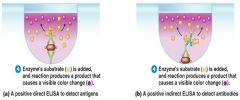
Which picture is direct and indirect in this test for ELISA test?
|
left to right: direct, indirect
|
|
|
|
Western blotting
|
gel electrophoresis of serum proteins
|
|
|
|
Borrelia burgdorferi
|
(causes Lyme’s disease) is often diagnosed by Western blot
|
|
|
|
Phage typing
|
used to look for similarities among bacteria
useful in tracing the origin and cause of a disease outbreak determines to which phages a bacterium is susceptible;phages are usually highly selective and can infect certain strains within a species used to determine sources of food-associated infections |
|
|

What test is this?
|
Phage typing
|
|
|
|
DNA fingerprinting
|
Electrophoresis of restriction enzyme digests
|
|
|
|
Polymerase chain reaction (PCR)
|
specific segments can be amplified to billions of copies in a couple hours
|
|
|
|
Denaturing Gradient Gel Electrophoresis
|
is a technique composed of urea and fomanide and helps see differences betw. amplicons.
|
|
|
|
The two strands on an amplicon are kept from completely denaturing by a
|
GC clamp that is added to one end.
|
|
|
|
Pyrosequencing
|
is a technique that can produce 500 million base pairs of sequence in a day.
|
|
|
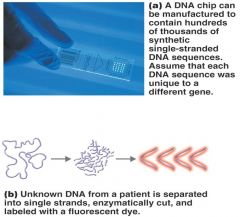
This is a picture of what? use?
|
Used to identify bacteria
|
|
|

What this a picture of?
|
A Cladogram
|
|

